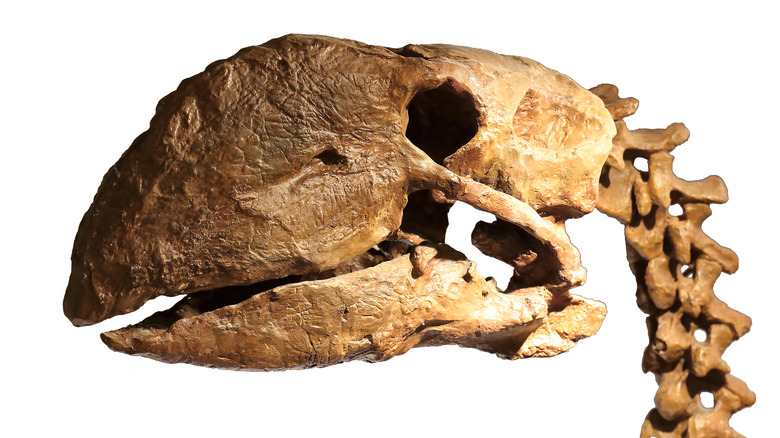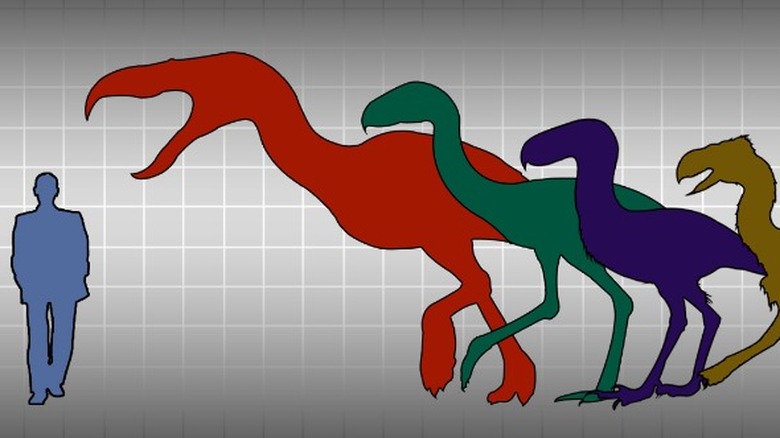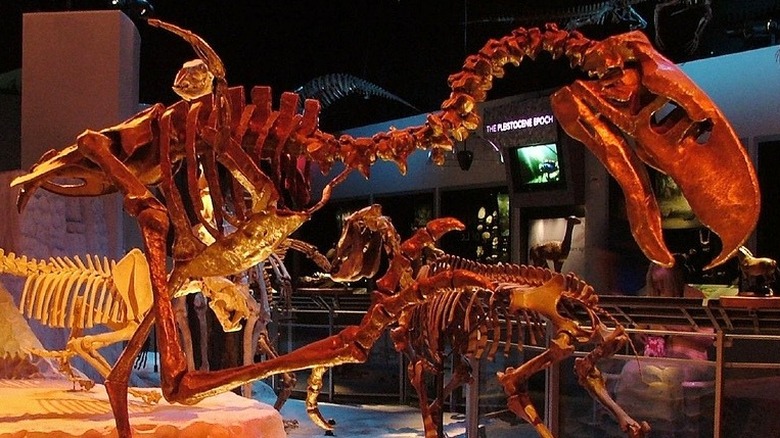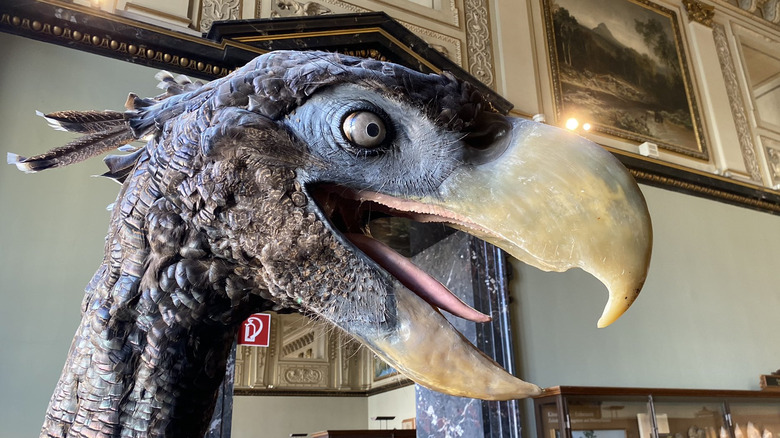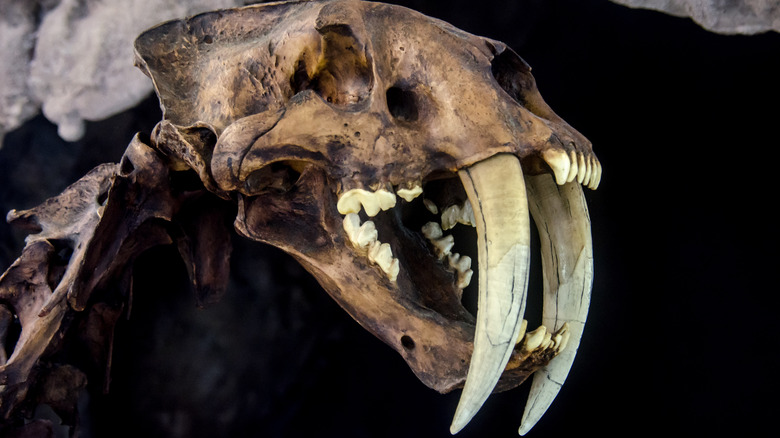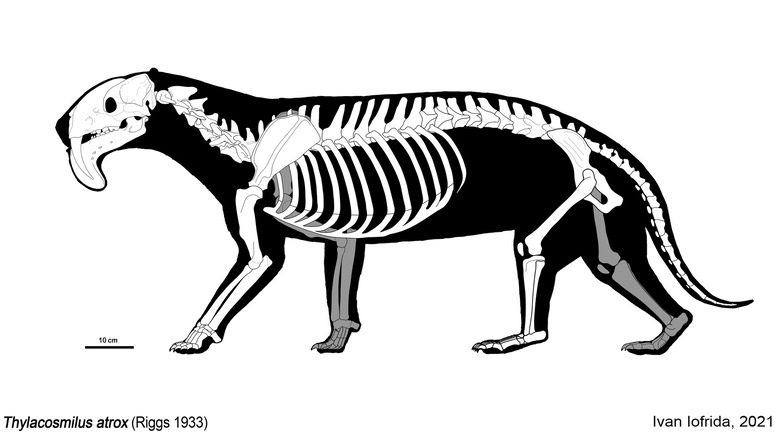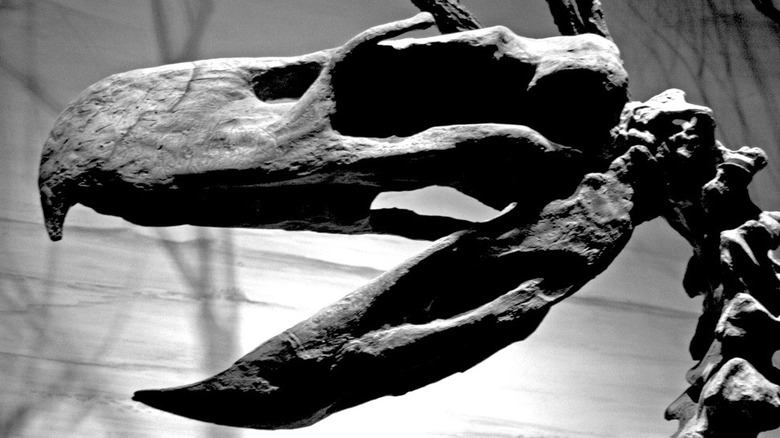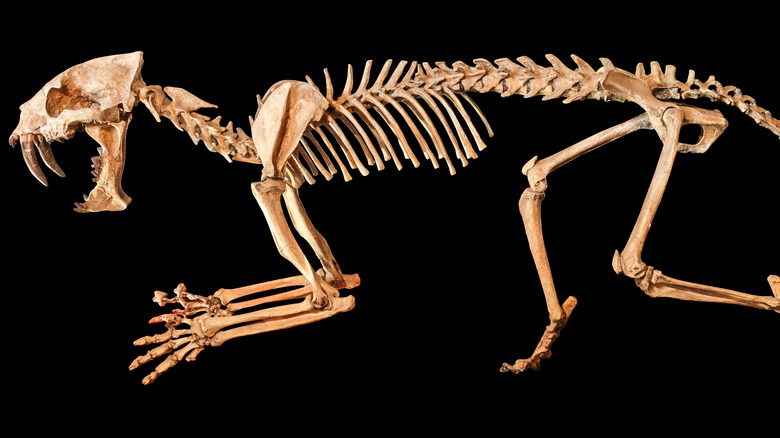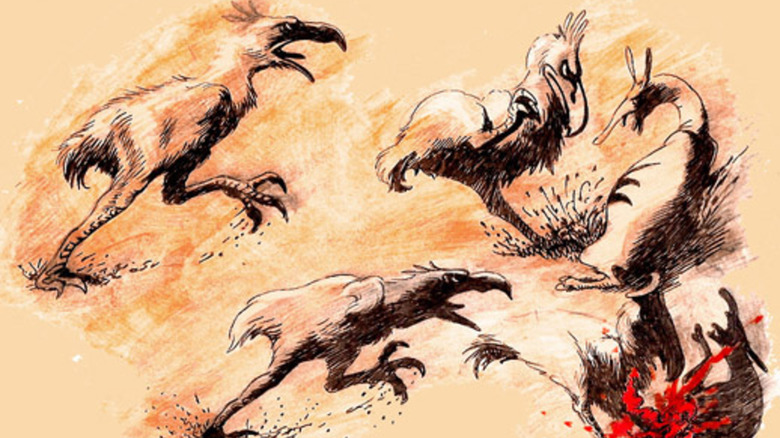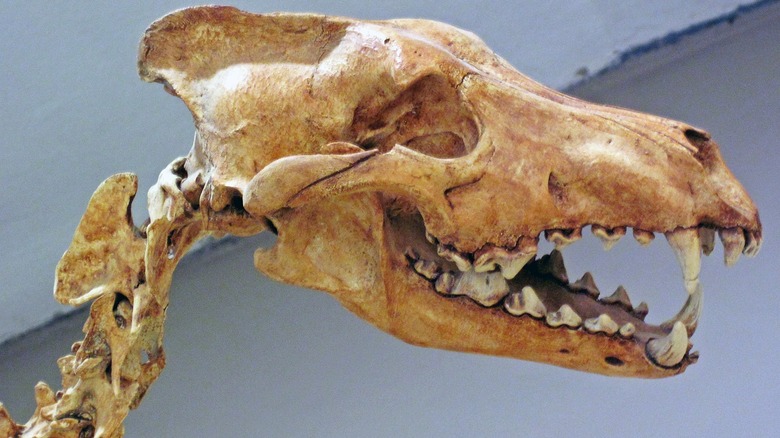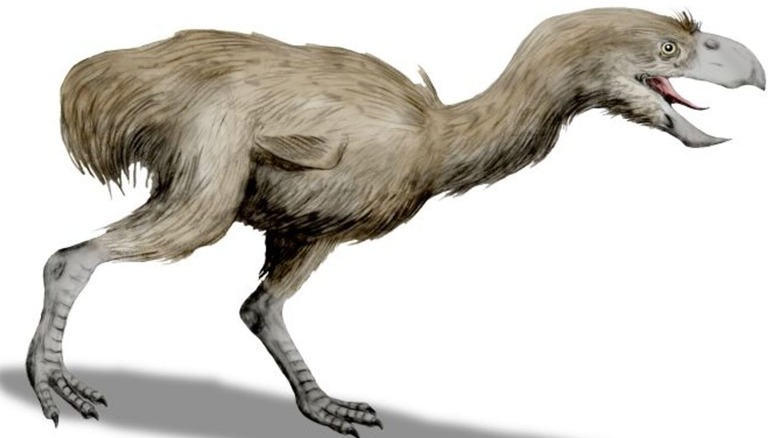Why The Terror Birds Went Extinct
Sixty million years ago, enormous carnivorous birds dominated the food chain in South America. This family of gigantic flightless birds, officially called phorusrhacids (per NBC), is better known by their colloquial name: terror birds.
The closest living relative of the terror birds is the red-legged seriema. According to the Peregrine Fund, these modern raptors often swallow small prey whole after slamming it into a rock to shatter the bones. They rarely fly and are fast runners like their ancestors, but are just under 3 feet tall. The terror birds were massive, some as large as 10 feet tall. As noted by Audubon, it's believed they could run as fast as a cheetah and usually hacked their prey to death with their sharp beaks.
The terror birds were incredibly successful. They were the top predator on the continent for millennia, impacting the evolution of every other creature in South America. Then, approximately 2 million years ago, they died off. There is debate over exactly what drove the terror birds to extinction, but looking at what else was happening when they vanished provides some compelling theories. It was the dawn of a new ice age, according to The New York Times. Glaciers were expanding and temperatures were dropping. Deep sea mountains were rising out of the oceans and connecting continents, allowing creatures to walk to entirely new environments. The world was changing and the mighty terror birds would not survive.
Birds were apex predators
Until their extinction, the terror birds were the deadliest creatures in South America. In modern times, it can be difficult to imagine birds at the top of the food chain. Audubon, however, notes these enormous birds were significantly different from the birds that currently live on planet Earth. They were huge, the largest standing over 10 feet tall. These weren't lumbering, slow-moving creatures. It's believed they could run faster than 60 mph. Modern birds like ostriches and cassowaries can do serious damage, but neither possess the enormous beaks of terror birds, which have been described as axe-like.
The terror bird was built for success. For tens of millions of years, creatures with similar body types to the flightless terror bird were highly successful, paleontologist John Flynn said to NPR. Many of the top predators that came before the terror bird, including the infamous Tyrannosaurus Rex, also had massive skulls, small forelimbs, and long legs. Around 2 million years ago, however, something changed. The world was reforming, and the apex predator who had dominated an entire continent for millennia would be driven to extinction.
Terror birds died long before humans
Many massive creatures in the Americas, like the saber-toothed tiger and woolly mammoth, went extinct about 10,000 years ago, near the end of the last ice age. The exact reason for their extinction is hotly debated, but many experts believe the arrival of humans sparked this mass extinction event, according to Smithsonian Magazine. At one time, it was believed at least one of the terror birds — the staggeringly large Titanis walleri — might have been one of the many huge animals to go extinct around 10,000 years ago. Could humans have been responsible for wiping out these deadly birds?
The Titanis walleri is thought to be the largest species of terror bird. According to BBC News, they were 7 feet tall and likely weighed more than 300 pounds. Titanis walleri fossils have been found in North America and at one time, scientists believed these titans shared North America with humans. More recent analysis show this is almost certainly incorrect. Examination of remains shows the most recent terror bird lived 2 million years ago, far too early to have had any overlap with human populations. So while humans weren't around to cause the extinction of the terror birds, there were other major changes going on in the world when the terror birds died.
Terror birds had been isolated
When the terror birds reigned in South America, the continent was an island. Then, according to Columbia University, a combination of the movement of tectonic plates and volcanic activity formed a land bridge we now know as the isthmus of Panama. As new islands broke up the distance of open ocean between North and South America, animals who were strong swimmers were able to move from one continent to the other. When North and South America finally joined together and it was possible to walk from one continent to the other, creatures that had evolved completely independently of each other met for the first time. The first meeting of these unrelated species is known as the Great American Biotic Interchange, as described in "The Great American Biotic Interchange: Patterns And Processes."
Terror birds, who became apex predators through evolution, were able to dominate the ecosystem they were a part of — but when their home of South America was suddenly connected to North America, that ecosystem changed. As noted in an article from Wired, they were suddenly thrust into a situation that was entirely different from the one that they had adapted to over millions of years.
It was hard for terror birds in North America
Since terror birds, including the enormous species called Titanis walleri, evolved to thrive in South America, those that left the continent were not as successful. In North America, the Titanis walleri lived in modern-day Texas. Somehow, their arrival on the continent seems to predate the formation of the Panamanian land bridge. As described by PBS, some experts believe they were actually able to swim between continents.
With the formation of a new land bridge, many species of terror birds that did not swim between continents were able to leave South America for the first time. Terror birds were undefeated on their home continent, where they had been at the top of the food chain since the dinosaurs went extinct. In North America, they were in an entirely new environment they were not prepared for. Like many other South American species which attempted to roam North, they were not as successful outside of their own ecosystem.
With some exceptions, the animals from South America that moved to North America did not fare well. One reason for this is that North America was populated with many large predators, whereas South America was only home to some predatory marsupials and the terror bird. Without defenses against these new predators, South American animals in the North were easy prey. The terror birds faced true competition for food for the first time, which put them on the road to extinction.
Terror birds were invaded
The terror birds who migrated to North America had to contend with competition from deadly North American predators for the first time — but they weren't the only ones. Soon, the terror birds who stayed in their own South American habitats were overrun with North American animals too.
According to PBS, the North American animals that arrived in South America thrived and multiplied. So much so that today, approximately half of modern South American animals are descended from animals that arrived from North America during this era.
While terror birds and the other South American animals that traveled to North America were largely unsuccessful there, North American animals that moved south thrived in their new environment. Terror bird expert Larry G. Marshall told The New York Times this is likely because South American animals had never had to deal with animals from other ecosystems, while animals from Europe and Asia sometimes arrived in North America. New animal species, including enormous mammalian predators like bears, wolves, and saber-toothed tigers flooded into South America.
The terror birds suddenly had to compete with other large predators to survive. Although they had previously been the top predator in South America, they were no match for the North American mammals.
South American terror birds weren't used to competition
It's believed that one of the major factors in the extinction of terror birds is that they weren't able to compete with other predators for food. One of the main reasons for this is they likely hadn't had to compete for anything in a very, very long time. As noted by The New York Times, before the land bridge connected North and South America, they had no competitors left. Terror birds were the biggest and fastest killers in the entire continent of South America.
The only other large predators in South America, at least since the dinosaurs, were a hyena-like animal dubbed Borhyaena and a saber-toothed marsupial called Thylacosmilus. By the time the land bridge between North and South America formed, both predators had gone extinct, leaving only the terror birds as the undisputed apex predators of South America. When enormous North American hunters like bears and saber-toothed tigers arrived in their ecosystem, the terror birds had no defenses.
As explained by paleontologist Luis Chiappe in an interview with Wired, suddenly having competition for resources would have forced the terror birds to develop new strategies for hunting their prey for the first time. If they were unable to adapt, they would not have survived.
The terror birds could have been more vulnerable than they looked
The terror birds have a fearsome reputation. In an article from The New York Times, they were described by expert Larry G. Marshall as "probably the most dangerous bird ever to have existed." So how could these deadly beasts have been so vulnerable to the invasion of North American mammals?
Some experts have suggested that terror birds were not able to hunt a wide range of prey, or that they had weaker bites than was previously believed, as described by Wired. One analysis of terror bird remains found their calcium isotope compositions made it seem as though they ate a plant-based diet rather than hunting for prey. If this were the case, there would be a gap in the ecosystem, with no top predator in South America, which would have made it easy for the mammalian predators from North America to dominate in the South and drive the terror birds to extinction. However, the majority of experts have rejected this theory. It is generally considered more likely that the terror birds were impressive predators, just not as successful as their North American counterparts.
Newer predators were more successful
The terror birds evolved to dominate the South American ecosystem, striking down small prey and consuming them whole. Despite South America being an entirely new environment for the North American predators that arrived on the Panamanian land bridge, they were able to not only survive but outcompete the continent's apex predator. According to Larry G. Marshall's "The Terror Birds of South America," many of these competitive predators were Canidae and Felidae — better known as cats and dogs.
What made these early cats and dogs so much more successful as predators than the formidable terror birds is still debated. Although it is believed that terror birds were extremely fast and agile, it's possible that the fact that the four legs of North American predators made them even quicker. It has also been suggested that cats and dogs were more intelligent than terror birds, which allowed them to capture prey more easily.
They couldn't fight large animals
In many ways, terror birds were incredibly effective predators, but the adaptations which made them such adept hunters may also have made them vulnerable to extinction. As described in a 2010 research article published by Plos One, analysis of terror bird skulls indicates they specialized in small prey they could swallow whole or hack with their hatchet-like beaks before consuming. Attempting to fight a large animal would have been risky for the terror birds. Although they were deadly to the small prey they had evolved to hunt, any physical confrontations with the large mammals that migrated into South America were extremely dangerous for terror birds.
In an interview with NBC, Lawrence Witmer, one of the study's co-authors, describes how the terror bird's beak was ideal for deadly downward strikes or crushing prey in a single bite. They would not have been able to grab and shake a large animal like many modern predators (and possibly ancient ones like the Tyrannosaurus Rex). It's highly unlikely that terror birds would have been successful in eating or fighting large animals.
They could have become prey
The primary explanation for why the terror birds went extinct is that they weren't able to cope with the sudden influx of new predators coming into their ecosystem, but it is possible these new mammals killed off the terror birds in a more direct way. As described in an article by Larry G. Marshall published in Scientific American, there is no physical evidence that the Canidae and Felidae who arrived in terror bird territory hunted them or their young directly, but their extinction directly correlates with the arrival of these deadly mammals.
Adult terror birds were most likely too massive and deadly to have been worth hunting down for food, but that doesn't mean they were safe from becoming prey. The massive terror birds lived on the ground and likely nested on the ground as well. With their nests easily accessible, it's possible that the large cats and dogs from North America ate terror bird eggs. They might also have hunted small terror bird hatchlings.
There is still debate about what killed the terror birds
There is still a lot to learn about the terror birds. As noted by an article by Larry G. Marshall published in Scientific American, while researchers have made exciting discoveries and created plausible explanations for the extinction of the terror bird, it's impossible to ever be entirely certain what happened to them by analyzing their bones.
Newer fossil discoveries have indicated terror birds were more diverse than previously believed, which would have made them harder to outcompete, according to the Society Of Vertebrate Paleontology. Also, just because the terror birds went extinct around the time large predators from North America arrived, that doesn't necessarily mean those predators caused their extinction, notes a 2011 paper published in the Journal of Mammalian Evolution. Rather than outcompeting the terror birds and driving them to extinction, it is possible that the North American mammals simply arrived at the right time to replace South America's apex predator, which was already dying off.
The world was changing
Terror birds managed to thrive at the top of the food chain for millions of years. As stated by zoologist Ross Piper (quoted via NBC), it probably would have taken a combination of factors to force them to go extinct. It's very likely there was no single cause of extinction for the terror birds. A probable factor is a massive change in the environment.
The formation of a land bridge between North and South America and the resulting mingling of many previously isolated species was not the only major change going on when the terror birds went extinct. As described by PBS, the entire climate was changing and a new ice age was beginning. The temperature dropped dramatically and glaciers expanded. The terror birds had been the dominant species in South America for several million years, but the world in which they were the apex predator was changing. It's possible the terror birds simply couldn't survive in the new environment that they found themselves in.
